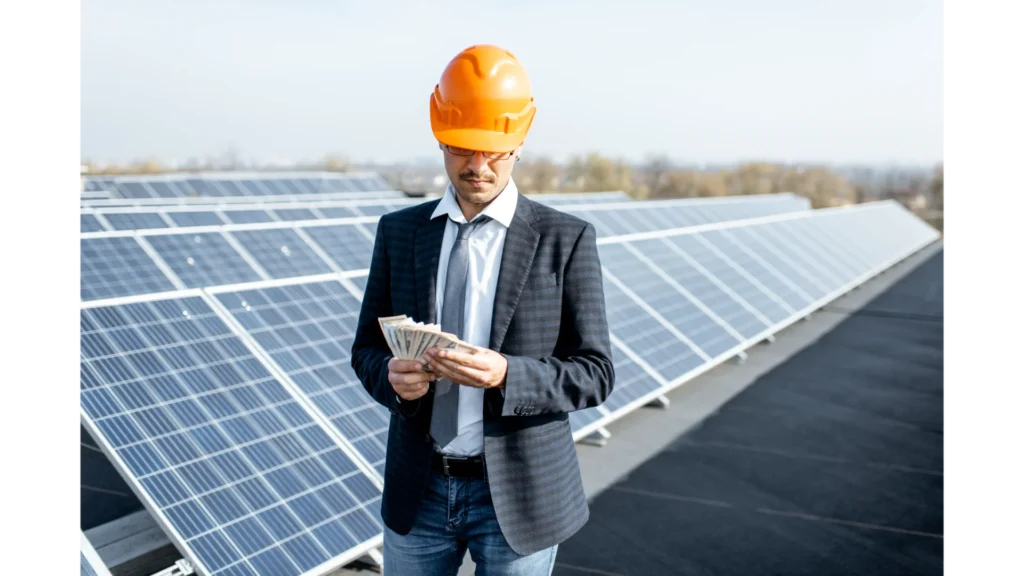
Solar panel installation is an increasingly popular investment for homeowners and businesses, thanks to the financial and tax incentives available. Not only does it provide a renewable energy source, but it can also lead to significant cost savings on electricity bills in the long run. Additionally, utility companies often offer options to make the transition to solar power even more accessible.
However, the upfront cost of installing solar panels can be a barrier for many individuals and companies. Fortunately, various financing options such as financial incentives, personal loans, and programs are available, making installing renewable energy systems more accessible.
This article will explore the financing options available for solar panel installation, including purchasing outright, solar loans, solar leases, power purchase agreements, and government incentives/rebates. By understanding these options, individuals and businesses can make informed decisions about how to finance their solar panel installation and take a step towards energy independence and financial freedom.
The acquisition of solar panels through direct ownership involves a one-time payment for the equipment, enabling the user to generate electricity from the sun’s energy. This financing option provides the most extended financial benefits in terms of energy savings and environmental impact.
Homeowners can reduce their monthly electric bills by purchasing solar panels outright while contributing to a cleaner environment. Moreover, owning a solar panel system increases property values and may entitle homeowners to tax credits or rebates.
One significant advantage of outright purchasing solar panels is that it eliminates ongoing payments, such as leasing or Power Purchase Agreements (PPAs). Homeowners have full control over their energy production and can design their systems according to their needs. Additionally, they are not subject to any service fees or penalties associated with leasing agreements or PPAs.
While a mortgage or personal loan requires an upfront investment, it ultimately results in greater long-term savings for homeowners. The loan terms and loan amount are important factors to consider when deciding on this type of financing.
In conclusion, purchasing solar panels outright is an excellent option for those looking for personal loans and financial independence. It provides homeowners with complete control over their renewable energy source, reduces monthly utility costs significantly, and contributes to a cleaner environment. Although it may require substantial upfront capital investment, it offers greater savings potential in the long term than other loans or funding options such as leasing or PPAs.
Solar loans provide an effective means for homeowners to finance the upfront costs of acquiring and installing photovoltaic systems through equity financing. These types of loans can be obtained from various sources, including banks, credit unions, and specialized lenders, providing funding for mortgage and contractor expenses.
The repayment period for a mortgage typically ranges from 5-20 years, depending on the lender’s terms and conditions. One significant advantage of renewable energy system loans is that they enable homeowners to own their solar panels outright instead of leasing them. This equity financing option can be repaid over several months.
This ownership provides greater financial flexibility in the long run, enabling homeowners to benefit fully from any tax credits or incentives available for solar panel installation. Additionally, homeowners may secure more significant savings on their monthly utility bills with a loan than with a lease agreement for renewable energy systems. Funding from loans and mortgages can greatly support the installation of solar panels.
Before obtaining a solar loan, it is essential to evaluate your credit score, as it can significantly impact your eligibility for favorable rates and terms. It is also beneficial to research different lenders’ offers for home equity financing, mortgage, and funding and compare them against one another before making a final decision.
As with any financial commitment, it is crucial to read the loan documents’ terms and conditions before signing anything. Overall, solar loans are an excellent financing option for those who want to invest in renewable energy without breaking the bank or being locked into long-term leases.
One popular method of acquiring renewable energy for homeowners is through a leasing agreement, where the system is installed on their property and leased to them by a third party. This option allows homeowners to access solar power without paying upfront installation costs. It provides an alternative to taking out loans or personal loans to cover the expense of installing solar panels. With this option, homeowners can avoid needing a mortgage and the associated interest payments.
The leasing company owns the solar panels and is responsible for their maintenance, while the homeowner pays a monthly fee for using the system. Solar leases typically come with long-term contracts lasting up to 20 years and often include an escalator clause that increases the monthly payments over time. These leases are a popular option for homeowners who want to go solar without taking out loans or paying a large loan amount upfront. Additionally, solar leases may have tax benefits associated with them.
However, solar financing leases can still provide significant savings on energy bills compared to traditional electricity sources. Additionally, some leasing companies offer buyout options or allow homeowners to transfer the lease if they sell their property. Finance solar panels and benefit from the solar installation.
While solar leases may not be ideal for everyone, they can be a viable option for those who want to go green without breaking the bank. Homeowners must research and compare financing options, including loans, before committing to any one plan.
By weighing the pros and cons of each method, it’s possible to find a financing solution that fits one’s budget and lifestyle while helping preserve our planet’s resources in the process.
Power Purchase Agreements (PPAs) are another type of contract allowing homeowners to access renewable energy without owning or maintaining the system.
PPAs involve a third-party provider who installs and maintains solar panels on the homeowner’s property.
The homeowner then agrees to purchase the electricity generated by the solar panels at a fixed rate, typically lower than their current utility rate. This system allows homeowners to save money on utility bills for years through reduced rates and loans.
One advantage of PPAs is that homeowners can benefit from renewable energy without upfront costs or maintenance responsibilities.
Additionally, because the rates are fixed, homeowners have greater predictability in their energy costs and can potentially save money over time.
However, it’s important for homeowners to carefully review and understand all terms of the PPA before signing, including potential fees for early termination or system removal.
PPAs may not be available in all areas or with all providers, so homeowners must research options and consider consulting with a professional familiar with renewable energy financing.
Overall, PPAs offer another option for those interested in accessing solar power without bearing the full cost and responsibilities of owning and maintaining a system. Additionally, PPAs can be a great alternative to traditional loans or home equity financing for those looking to obtain credit for their solar energy projects. With a PPA, homeowners can enjoy the benefits of solar power without needing a home equity loan.
Incentives and rebates offered by governments can significantly promote the adoption of renewable energy sources, such as solar panel systems, by making them more financially feasible for homeowners. One way to make solar panel systems more affordable is through solar loans, which allow homeowners to finance the purchase and installation of their solar panel systems. These loans are often based on creditworthiness, making it important for homeowners to have a good credit score to qualify for favorable loan terms.
Governments worldwide have initiated several programs encouraging people to switch to solar power.
The United States, for example, offers a federal tax credit for homeowners installing a solar panel system, allowing them to claim 26% of the installation cost as a credit on their income taxes. This can help make solar loans more affordable with lower interest rates.
Similarly, many states offer incentives such as cash rebates or property tax exemptions.
Apart from the United States, countries like Australia, Germany, and Japan have also implemented various incentive programs to promote renewable energy use at home.
For instance, Australia has introduced the Solar Homes Program that provides subsidies of up to $1850 for solar panel installation.
Germany has introduced feed-in tariffs that allow homeowners with solar panels to sell excess electricity back to the grid at premium rates, which can help them earn credit and repay their loans.
In contrast, Japan offers an incentive program called Feed-in Tariff System for Renewable Energy that offers higher fixed rates per kilowatt-hour (kWh) generated through renewable sources. This program especially benefits homeowners considering a solar loan or using their home equity to finance their renewable energy projects.
The availability and extent of incentives and rebates for solar loans, home equity, and credit vary from country to country and even within states.
However, these programs can significantly reduce the initial costs associated with installing solar panels while helping individuals transition towards using clean energy sources.
As societies continue transitioning towards sustainable living practices in response to global warming concerns, government incentives will continue playing an essential role in driving this progress.
Solar panel installation is popular for those looking to reduce their carbon footprint and save money on energy bills. Many people are opting for this green energy solution, especially with the availability of credit and loan options for home improvements.
There are various financing options available for those considering solar panel installation. One option is purchasing the solar panels outright, which provides the most long-term savings but requires a large upfront investment.
Solar loans, leases, and power purchase agreements offer more flexible home solar panel installation payment plans. These options may result in higher overall costs but government incentives, and rebates are available to help offset the credit cost.
These options vary by state and can significantly reduce the upfront cost of purchasing or leasing solar panels. It’s important to research all financing options before deciding to ensure that your investment in solar energy is both financially viable and environmentally responsible.
Overall, with the right financing plan, installing solar panels can be an excellent way to save money on energy bills while reducing your environmental impact. Additionally, if you need a loan to cover the upfront costs of installing solar panels on your home, various credit options are available to help make it more affordable.
The long-term effects of solar panel installation on the environment are a growing interest amongst researchers and policymakers alike. Solar energy represents one of the most promising alternatives to traditional fossil fuels, with significant potential for reducing greenhouse gas emissions, improving air quality, and mitigating climate change impacts. However, the environmental impact of solar panel production and the management of end-of-life panels must also be considered. While current research suggests that these impacts are relatively minor compared to those associated with conventional energy sources, ongoing efforts in research and development are necessary to further reduce their environmental footprint. Overall, the adoption of solar energy has immense potential to promote a sustainable future by reducing our dependence on non-renewable resources and improving our collective ecological footprint.
Maintenance requirements and associated costs for solar panels vary depending on the specific system installed. Routine maintenance involves cleaning the panels periodically to remove dirt and debris that may accumulate over time. This can be done with a soft cloth or hose. In addition, checking for any physical damage or wear is also recommended. The maintenance cost will depend on factors such as the size of the system, location, and any necessary repairs. However, it is generally considered a low-maintenance option compared to other forms of energy generation. While installation may have upfront costs, the long-term benefits of reduced energy bills and environmental impact make it an attractive option for those seeking sustainable energy solutions.
The excess energy generated by solar panels is often sent back to the grid and used by other consumers. This process is known as net metering, where homeowners can receive credits on their utility bills for the excess electricity they generate. In some cases, homeowners may also have the option to sell their excess energy back to the utility company at a predetermined rate, which can help them repay their loan. However, policies regarding net metering and selling back excess energy vary depending on location and utility provider. Some states may have more favorable policies than others, which homeowners should be aware of when considering installing solar panels.
Research has shown that solar panels can significantly increase the resale value of a home. The exact amount varies depending on factors such as location, size of the system, and local housing market trends. A Lawrence Berkeley National Laboratory study found that homes equipped with solar systems sold for an average of $15,000 more than comparable non-solar homes. Another study from Zillow showed that homes with solar energy systems sold for 4.1% more than their counterparts without solar. These findings suggest that investing in solar panels benefits homeowners in terms of energy savings and provides a valuable asset when it comes time to sell their property.
Solar panels are a popular and effective way to reduce energy costs and carbon emissions. However, not all roofs are suitable for solar panel installation. Some factors that affect the suitability of a roof include orientation, shading, age, condition, and structural integrity. For instance, roofs that face south or west receive more sunlight than those facing north or east. Similarly, roofs shaded by trees or buildings may not receive enough sunlight to generate sufficient electricity from solar panels. Additionally, older or damaged roofs may need repairs or reinforcements before installing solar panels to ensure safety and durability. Therefore, it is important to consult with a professional installer to assess your roof’s suitability for solar panel installation and any restrictions that may apply based on local regulations or building codes.

Can I Lease Solar Panels Instead Of Purchasing Them? Share: Facebook Twitter LinkedIn Pinterest As the world becomes increasingly environmentally conscious, more individuals and businesses

How Long Will It Take For My Solar Panels System To Pay For Itself? Share: Facebook Twitter LinkedIn Pinterest Investing in a solar panel system

How Does The Installation Of Solar Panels Affect My Property Taxes? Share: Facebook Twitter LinkedIn Pinterest With the increasing concern for the environment and the

What Happens If My Solar Panels Generate Excess Solar Power? Share: Facebook Twitter LinkedIn Pinterest Solar Panels Generate More Electricity Than I Use As more

How Does The Installation Of Solar Panels Affect My Homeowners Insurance? Share: Facebook Twitter LinkedIn Pinterest How Solar Panels Affect My Homeowners Insurance The installation

State Grants Share: Facebook Twitter LinkedIn Pinterest The Database of State Incentives for Renewables & Efficiency (DSIRE) is a comprehensive source of information on federal,